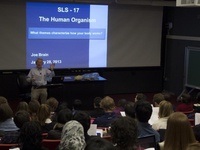
Professor Joseph D. Brain stands before a chalkboard in a photo taken between 15 and 20 years ago, by his estimate. Brain will teach his course "The Human Organism" for the final time this spring.
When Joseph D. Brain delivered the first lecture of his new physiology course “The Human Organism” in 1971, scientists had not yet eradicated smallpox, profiled DNA, or discovered HIV.
The men and women who filled the seats of Brain’s classroom that first day had only just begun living in the same residential Houses months before. And when they signed up for his class, these undergraduates enrolled under the old General Education curriculum, which would not be superseded by the new Core Curriculum for another eight years.
On Monday, more than four decades later, Brain delivered his first lecture of another semester of the course now titled Science of Living Systems 17: “The Human Organism”—for the 40th and final time. Brain, a professor at the Harvard School of Public Health, has decided this semester’s offering of the course will be his last as he plans to devote more time to research. He has only skipped one year of teaching the course since its inception.
Despite the changes that have swept the scientific community and Harvard’s campus since the course was first offered more than 40 years ago, the fundamental mission of the class has remained unchanged: to make “The Human Organism” relevant to topics in public health, undergraduate interests in the humanities and social sciences, and current events.
SCIENCE WITHOUT BORDERS
In 1971, two years after joining the faculty at the School of Public Health, Brain decided that he wanted to teach undergraduates to think more critically about public health. At the time, he felt that College students lacked knowledge about the discipline, which he believed had important connections to subjects beyond medicine or even science.
“The context is that health really is a big deal. Whether you feel well or if you get certain diseases, it’s a huge part of our life, and it’s a huge part of the economy,” Brain said in an interview last week. “I really want people to understand the determinants of health: of their own individual health, of the people of the United States, global health.”
From the beginning, Brain sought to use the lecture component of the course to emphasize connections between his subject material and public health trends. But about ten years into teaching the class, he altered its structure to better reflect that goal.
He introduced topic sections devoted to exploring a specific subject, such as tuberculosis or obesity, into the section component of the course. Students in topic sections choose a focus within that subject and work toward writing a term paper.
Undergraduates who have taken the course say that the topic sections have given them a new perspective on public health. Rebecca A. Betensky ’87, a former student in the course, translated her topic section into a career path. Though she originally took Brain’s course to fulfill a Core requirement, her section on epidemiology helped her fine tune her interest in math into a passion for biostatistics.
“That was really enlightening to me,” Betensky said. “It was really exciting for me to see some applications of math in medical and scientific research, so that really sparked my interest in biostatistics.”
Betensky went on to get her Ph.D. in the subject. She is now a professor of biostatistics at the School of Public Health.
JACKS OF ALL TRADES
Brain has also sought to make his course relevant to non-science undergraduates. He says it is not designed for science students and estimates that only about 15 to 20 percent of students enrolled in the past have studied math or science.
Nancy C. Long Sieber, a longtime instructor for the course who once taught a topic section on battlefield medicine, said “The Human Organism” offers students the chance to explore diverse interests.
Read more in College News
Classes Address Collaboration Policies














